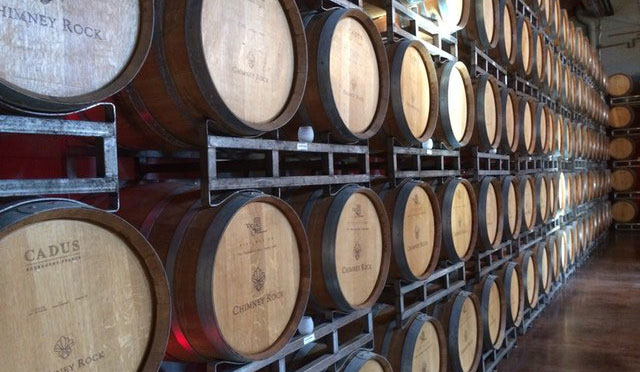
Most casual wine drinkers are surprised that wine varietals, or non-blended wine, don’t have to be made with 100% of the same grape. Though the immediate reaction may be one of dismay, blending plays a considerable role in winemaking and shouldn’t be dismissed as some ploy.
In the United States, wine has to contain at least 75% of a single grape type to be considered a varietal. The rules are more strict in Europe at 80%. Some countries like Argentina, Australia, Chile, and New Zealand have even higher grape type requirements.
Let’s take a closer look at why wine is blended and how it affects the final product.
Why Do Winemakers Blend?
Wine blending is akin to an artist mixing paints on a palette. It allows winemakers to create complex and balanced flavors that a single grape variety cannot achieve alone. By combining different grape varieties, winemakers can adjust the balance of acidity, tannin, and alcohol, enhancing the bouquet and depth of the wine.
This process also enables the smoothing out of variations between different batches of wine, ensuring consistency across vintages. For instance, a wine that is too acidic might be balanced with a variety with lower acidity levels, or a particularly tannic wine could be softened with a smoother, more fruit-forward variety. This meticulous crafting results in a harmonious final product that reflects the winemaker’s vision and skill, offering a unique tasting experience that captivates the palate.
Red Wine Blends
Creating the finest wine blends is an art form that has been perfected over centuries. Some of the most famous and sought-after red wine blends include Bordeaux, Rhône, and Port. These wines typically combine two or more grape varieties, each providing exceptional characteristics to the final blend.
Here are some famous red wine blends that you may have come across:
Bordeaux
This iconic red wine blend from France’s Bordeaux region typically includes a combination of Cabernet Sauvignon, Merlot, and Cabernet Franc grapes. It produces full-bodied wines with complex flavors and aromas. The grape varieties balance tannins and acidity, creating a rich and well-structured wine.
Rhône
The Rhone Valley in France is popular for its Syrah, grenache, and Mourvèdre grape blends, known for their bold flavors and spice. These blends often include a small amount of white grapes, such as Viognier, to add a floral and aromatic component.
Port
Port is a sweet and fortified wine from Portugal. Port blends typically combine Tinta Barroca, Touriga Nacional, and Touriga Franca grapes. The different grape varieties add complexity and depth to the wine, creating a unique balance between sweetness and acidity. Some combinations also include white grapes like Malvasia or Muscatel.
Red wine blends are known for their versatility. They pair well with a variety of foods and occasions and offer a range of flavors and styles that can please any palate.
White Wine Blends
While red wine blends are popular, white wine blends have much to offer in intricacy and flavor. These blends often combine aromatic varieties like Pinot Noir with richer, fuller-bodied varieties like Chardonnay, creating a refreshing and complex wine with layers of flavors.
Let’s take a look at some popular white wine blends that you may be interested in trying:
Champagne
While we primarily associate champagne with its sparkling nature, it combines Chardonnay, Pinot Noir, and Pinot Meunier grapes. Each variety brings something unique to the table and contributes to the signature bubbly taste. For instance, Chardonnay offers elegance and finesse, Pinot Noir provides structure and depth, while Pinot Meunier adds a fruitiness to the blend.
Burgundy
Another famous French wine, Burgundy, is known for its Chardonnay and Pinot Noir blends. These wines are typically lighter-bodied with a delicate balance of fruitiness and acidity. The variety of soils and microclimates in the region allows for a range of blends that reflect the terroir.
These are just a few popular mixtures, but there are countless more to explore and enjoy. Each blend of wine has its own unique characteristics, making it an exciting and diverse world for wine enthusiasts to discover.
Benefits of Wine Blending
Aside from the benefit of creating a more complex and balanced wine, blending also offers various advantages for winemakers. Some of these include:
Flexibility: Blending allows winemakers to adapt to changing growing conditions or unexpected challenges during the winemaking process. They can adjust the blend despite unforeseen circumstances to create a high-quality wine.
Cost-effectiveness: Blending allows winemakers to make the most of their grape harvest. By combining different varieties, they can create a better-quality wine from grapes that might not have met the standards for a single varietal.
Marketability: Blended wines offer unique and complex flavor profiles that can attract both experienced and novice wine drinkers. They also allow winemakers to cater to different tastes and preferences, making their wine more appealing to a broader audience.
Wine blending is a crucial winemaking process that requires skill, knowledge, and experimentation. By incorporating different grape varieties, winemakers can create exceptional wines greater than the sum of their parts.
Challenges of Blending Wine
Although wine blending has its advantages, it also presents some obstacles for winemakers. These include:
Consistency: Achieving continuity across vintages can be challenging when using different grape varieties and proportions in a blend. Careful monitoring and adjustments are required to maintain the desired flavor profile.
Grape availability: Some grape varieties may not be readily available yearly, making it difficult to maintain stable blends.
Trial and error: There is a fine line between crafting a perfectly balanced wine mixture and ending up with an unappealing combination of flavors. Mastering the art of blending takes time, experimentation, and experience.
Despite these difficulties, winemakers continue to push the boundaries of what’s possible, resulting in a diverse and ever-evolving selection of wines for everyone to enjoy.


